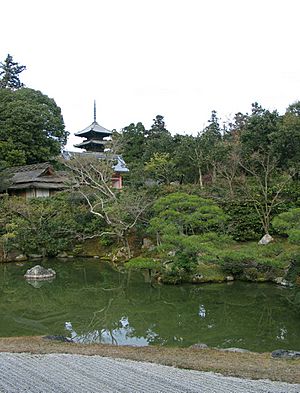Ninna facts for kids
The Ninna (仁和) period was a special way of counting years in ancient Japan. It was known as a nengō (年号), which means "year name." This period came after the Gangyō era and before the Kanpyō era. The Ninna period lasted from February 885 to April 889. During this time, two emperors ruled Japan: Emperor Kōkō and Emperor Uda.
Key Events of the Ninna Era
- September 17, 887 (Ninna 3): Emperor Kōkō passed away when he was 57 years old. His third son was chosen to take over as the next emperor. This process is called senso. Soon after, Emperor Uda officially became the new ruler in special ceremonies. This is known as sokui.
- May 12, 887 (Ninna 3): A powerful leader named Mototsune asked Emperor Uda if he could stop working. However, the emperor convinced him to keep serving as kampaku. A kampaku was a very important official who helped the emperor rule.
- 887 (Ninna 4): The construction of a large Buddhist temple complex called Ninna-ji (仁和寺) was finished. A monk who had been a student of the famous Kūkai (also known as Kōbō-daishi) was chosen to lead the monks living at this new temple.
Related Information
- Heian period - Learn more about the long period in Japanese history that the Ninna era was part of.
- National Diet Library, "The Japanese Calendar" -- This link shows a historical overview and pictures from the library's collection.
| Era Name | Year 1 | Year 2 | Year 3 | Year 4 | Year 5 |
|---|---|---|---|---|---|
| Ninna | 885 | 886 | 888 | 889 |
| Before this: Gangyō |
Japanese Era Ninna |
After this: Kanpyō |
Images for kids

All content from Kiddle encyclopedia articles (including the article images and facts) can be freely used under Attribution-ShareAlike license, unless stated otherwise. Cite this article:
Ninna Facts for Kids. Kiddle Encyclopedia.


